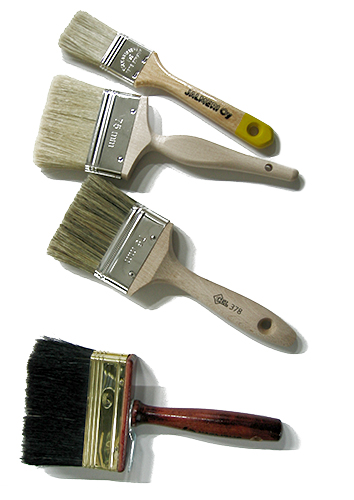Paingting products can be devided by solvent and adhesive and separate to paints and varnishes.
Paints are opaque and they have color pigments.Varnishes don’t have pigments and therefore produce a clear coat. Both of the paint products however, have adhesives, solvents and excipient. Paint products can also be grouped based on the solvent. Waterborne and solventborne paint.
Water-based dispersion paints, Latex paints
- paint material is dispersed in a liquid that consists mainly of water
- suitable purposes this has advantages in fast drying and low toxicity
- it can even be used on unprimed drywall or unpainted masonry
- easy application and easy to clean equipments with water
Today, many paints are made with water as the thinner but with resins that are not latex, and the industry is leaning toward such terms as “water-thinned” or “water-reducible.”

Solvent-based paints
- Oil paints
- slow-drying paint that consists of particles of pigment suspended in a drying oil
- the viscosity of the paint may be modified by the addition of a solvent such as turpentine or white spirit
- varnish may be added to increase the glossiness of the dried oil paint film
- Common modern applications of oil paint are in finishing and protection of wood in buildings and exposed metal structures such as ships and bridges.
- Its hard-wearing properties and luminous colors make it desirable for both interior and exterior use on wood and metal.
- Due to its slow-drying properties, it has recently been used in paint-on-glass animation.
- Thickness of coat has considerable bearing on time required for drying: thin coats of oil paint dry relatively quickly.
Fifty years ago, virtually all paint was solvent based. Sometimes referred to as Oil-based or Alkyd paints, solvent-based coatings contain higher levels of organic compounds than water-based coatings. These solvents or compounds facilitate application, drying and the formation of a durable, regular paint film. On the negative side, when these compounds evaporate, they release Volatile Organic Compounds (VOCs) into the atmosphere resulting in a strong odor and toxic impact on the environment. Stricter environmental regulations have required paint manufacturers to dramatically reduce the levels of VOCs in their paints.
Alkyd paints
- Oil-based paints are made with either alkyd (synthetic) or linseed (natural oils).
- Alkyd coatings are more common because they are less expensive and tougher than natural oil paints.
- the viscosity of the paint may be modified by the addition of a solvent such as turpentine or white spirit
- Common applications for Oil-based coatings include: residential trim, doors, cabinets and furniture, also metal doors and railings.
In recent years, the introduction of alkyd latex resin technology has allowed coatings manufacturers to combine the performance advantages of alkyd-based paint chemistries with the convenience of solvent-free, waterborne coatings. Waterborne acrylic alkyd hybrids provide easy clean up and low VOC levels, along with superior leveling and durability. By incorporating alkyd resin technology into their coatings, manufacturers can offer consumers paint that is ideal for trim, doors, cabinets and furniture.
Reaction paints
Urethanes are additives found in both waterborne and alkyd based coatings offering superior resistance to moisture and abrasion. Urethanes are a common additive to industrial coatings where maximum durability is required.
Epoxy Coating has generally two parts, which are mixed prior to application and consist of an epoxy resin that is cross-linked with a co-reactant or hardener.
- epoxy coating dries quickly
- tough and protective coating
- epoxy coatings are quick and easy to apply, making them ideal for a number of applications.
- Epoxy is typically used on concrete and steel to give resistance to water, alkali and acids.
- Epoxy is usually used in industrial, automotive and marine applications.